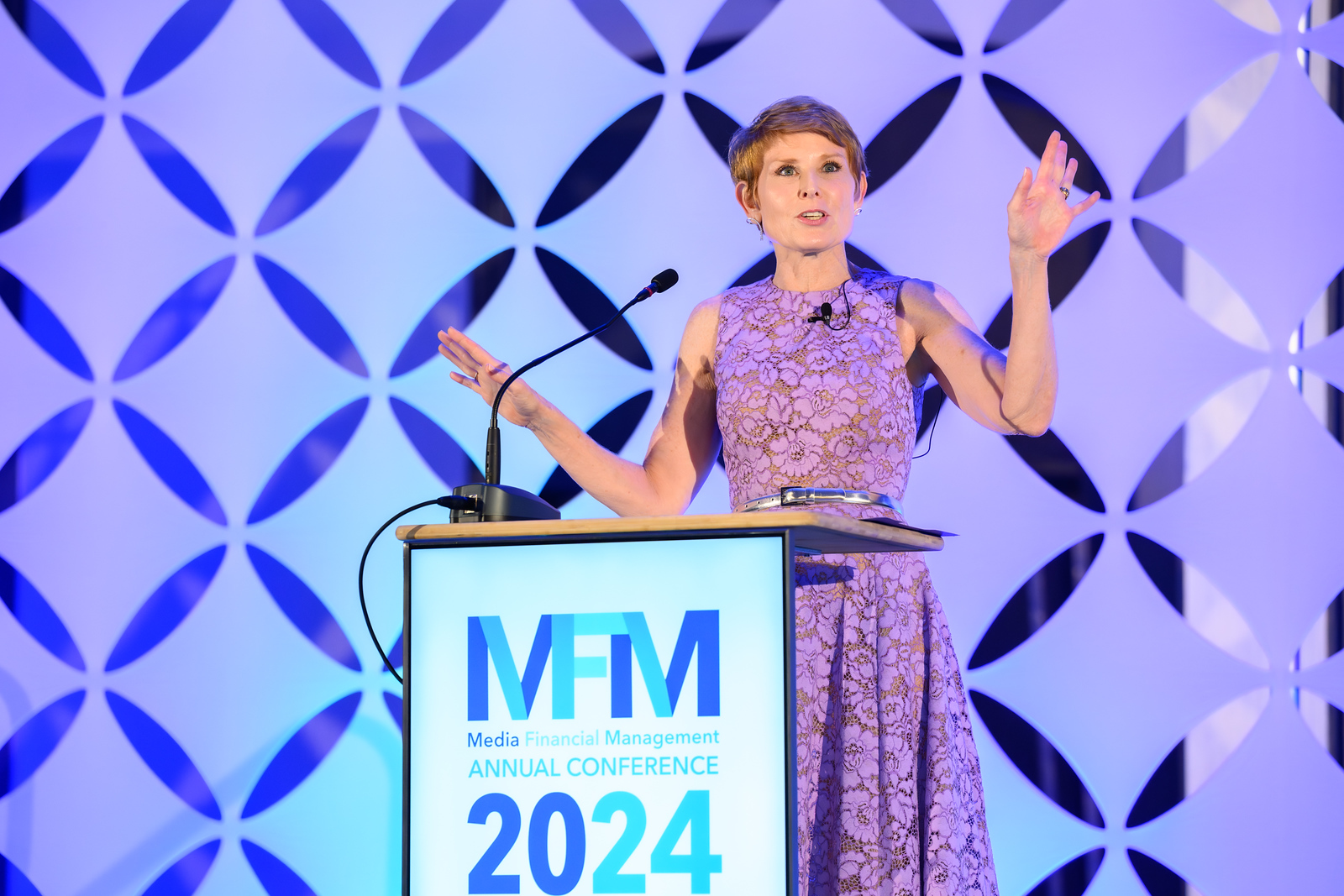KPMG’s Chief Economist's Keynote at MFM's Annual Conference: How the U.S. “Beat the Odds” and What’s Ahead for the Global Economy

“Should I stay or should I go?” That famous 1982 song from The Clash was the opening line from KPMG Chief Economist Diane Swonk, who shared her thoughts around if and when the Federal Reserve will cut interest rates further, a wide range of topics around the economy, and how the surprises of the past few years will ultimately affect those in the ballroom with her on May 20 at the 2024 MFM Annual Conference in Jacksonville, Florida.
Swonk offered a broad-brushed overview of global and national events, touching on interwoven factors that have resulted in a world that continues to recover and adjust following the pandemic, with a ripple effect that will undoubtedly trickle down to the media and entertainment industry. But what seems to be a surprise even to Swonk is that the U.S. – more than any other country in the world – somehow “beat the odds” in its response to the post-pandemic economic upheaval that continues to rock the globe.
So many issues in 2023 defied what people thought would happen to the global economy, starting with inflation, Swonk said. “Wall Street thought inflation would come down, and they were happy in Jackson Hole,” referring to the annual meeting of the world banks held each summer. “But we got ahead of ourselves.” The markets had rallied, and “my colleagues on Wall Street thought inflation was over. And then we came around the corner in 2024 and inflation re-accelerated, So, at what price did we beat the odds last year? Some are even thinking there may be a rate hike.”
Despite inflation’s effects and continued unknowns, the U.S economy rose 3.1% from fourth quarter of 2022 to fourth quarter 2023, Swonk noted. “And we expect about a 2% increase from Q423 to Q424, so we’re going to beat the odds again. We did it against most impressive credit tightening since the 1980s – and we outperformed all our peers around the world.” Swonk went on to explain the three primary reasons the economy beat the odds.
Swonk described the recovery of the U.S. economy as “a marathon that turned into a relay race.” She explained that three sectors dominated our economic boost: healthcare and social services; leisure and hospitality (“Everyone decided to go on vacation and they haven’t stopped”); and state and local government hiring (“Forty-six of fifty states exceeded their revenue projections last year.” She also noted the second two didn’t recover for 1.5 years after healthcare/social services
The return of the labor force is the second factor on the U.S. economy’s recovery. Hiring is still up and the job market posted its strongest positions since 2019, Swonk, said, but the complexion of the workforce has changed. Millennial women are a larger part of the labor force, and foreign-born workers have outpaced everyone. “Twelve thousand people are turning 35 each day,” Swonk noted, and though many Millennials want to buy homes, they can’t, so either settle on renting or wait for home loans – or inheriting a home – from their Baby Boomer parents. There’s also a childcare crisis: “childcare now costs 25% to double of what it costs for rent,” she stated.
Swonk’s third factor in the U.S.’s remarkable ability to beat the odds is productivity growth. Supply chains have finally begun to truly heal, even though we still have supply chain issues, such as the blockage of the Suez Canal in 2021 that caused the cost of shipping goods to increase sharply. “Most of the acceleration in inflation last year due to falling goods prices that had spiked during the pandemic,” she added. The tightened labor market has served to increase productivity as well: Swonk explained companies are more carefully selecting employees, and “when you match people to jobs, you get productivity growth.”
She cited the three largest economic problems as Immigraiton, social security, and the deficit.
Virtually every speaker at the conference touched on AI, and Swonk was no exception: Her view is that AI will rock our world but it’s different in that it’s the first general purpose technology that starts with a low cost and gets more expensive over time. “It’s data duration and data warehousing – those demand a lot of energy. it’s why tech companies are trying to secure nuclear plants, and are investing in renewables. This might be the accelerant we need for renewables.” She also expects AI’s productivity growth to not be evident until the 2030s.
Swonk ended by circling back to the Federal Reserve and the inflation issue. The Fed must continue to walk a tightrope of monitoring the rise of the U.S. economy and both the known and the unknown ways in which inflation will affect it. Healthcare, maintenance, childcare, and insurance have all gone up, straining many Americans’ budgets, even though wages and benefits have also risen. “But if you prematurely cut rates, you’re going to pay the price later in higher inflation. [Jerome] Powell remembers that all too well, so he’s keeping the Fed in a cautionary mode and needs to be convinced that inflation is fully on its way toward its 2% target before we cut rates again,” she opined.
“So for now the Fed is going to stay” Swonk concluded, “but we also beat the odds – and that’s something the U.S. knows a lot about.”
Posted at MediaVillage through the Thought Leadership self-publishing platform.
Click the social buttons to share this story with colleagues and friends.
The opinions expressed here are the author's views and do not necessarily represent the views of MediaVillage.org/MyersBizNet.


